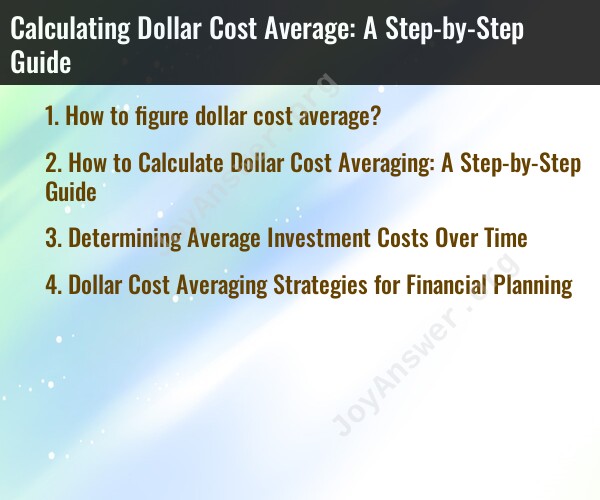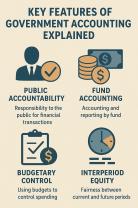How to figure dollar cost average?
Calculating Dollar Cost Averaging (DCA) is a straightforward process that involves determining the average cost of your investments over a specific period. DCA is typically used for ongoing, periodic investments, such as monthly contributions to your investment portfolio. Here's a step-by-step guide on how to figure your Dollar Cost Average:
Step 1: Gather Your Investment Information
Before you can calculate your DCA, you'll need the following information:
- The total amount you've invested over a specific period.
- The total number of shares or units of the investment you've purchased.
- The period for which you want to calculate your DCA (e.g., a month, a year).
Step 2: Calculate Your Total Investment
To calculate the total amount you've invested, sum all the contributions you've made during the chosen period. For example, if you contributed $100 each month for a year, your total investment would be $100 x 12 months = $1,200.
Step 3: Calculate the Total Number of Shares
Determine the total number of shares or units of the investment you've purchased during the same period. For each contribution, divide the amount invested by the share price at the time of the investment. Then, sum all these calculations. For example, if you bought 10 shares in January at $10 each and 12 shares in February at $12 each, the total number of shares would be 10 + 12 = 22 shares.
Step 4: Calculate Your DCA
To calculate your DCA, divide the total amount invested (Step 2) by the total number of shares (Step 3). This will give you the average cost per share or unit. For example, if you invested $1,200 in total and purchased 22 shares, your DCA would be $1,200 / 22 shares = $54.55 per share.
Step 5: Monitor Your DCA Over Time
Keep in mind that your DCA can change with each new contribution. If you continue to invest regularly, you can calculate your DCA periodically to see how it evolves. Your goal is to see your DCA decrease over time as you acquire more shares at lower prices.
Example:
Let's say you invested $100 each month for six months, resulting in the following purchases:
- January: 10 shares at $10 per share
- February: 12 shares at $12 per share
- March: 8 shares at $15 per share
- April: 15 shares at $9 per share
- May: 11 shares at $11 per share
- June: 14 shares at $13 per share
To calculate your DCA for this period:
- Total Amount Invested: $100 x 6 months = $600.
- Total Number of Shares: 10 + 12 + 8 + 15 + 11 + 14 = 70 shares.
- DCA: $600 / 70 shares = $8.57 per share.
In this example, your DCA is $8.57 per share over the six-month period. It represents the average cost of your investments during that time frame.
How to Calculate Dollar Cost Averaging: A Step-by-Step Guide
Dollar-cost averaging (DCA) is an investment strategy that involves investing a fixed amount of money at regular intervals, regardless of the price of the investment. This can be a good way to reduce the impact of volatility on your overall investment costs.
To calculate your dollar-cost average investment cost, follow these steps:
- Determine your total investment amount. This is the amount of money you plan to invest over a certain period of time.
- Divide your total investment amount by the number of investment intervals. This will give you the amount of money you will invest each interval.
- Invest your fixed amount at each interval, regardless of the price of the investment.
- Track your investments over time. This will help you to see how your dollar-cost averaging strategy is working.
Here is an example of how to calculate dollar-cost averaging:
Let's say you want to invest $1,200 in the S&P 500 over a period of 12 months. You plan to invest $100 per month.
Your dollar-cost average investment cost would be calculated as follows:
Total investment amount / number of investment intervals = dollar-cost average investment cost
$1,200 / 12 = $100
This means that your dollar-cost average investment cost for the S&P 500 would be $100 per share, regardless of the price of the S&P 500 at each investment interval.
Determining Average Investment Costs Over Time
Dollar-cost averaging can help to reduce the impact of volatility on your overall investment costs. This is because you will be buying more shares when the price of the investment is low and fewer shares when the price of the investment is high.
Over time, this can help to lower your average investment cost.
Dollar Cost Averaging Strategies for Financial Planning
Dollar-cost averaging can be a good investment strategy for a variety of financial planning goals, such as retirement savings, college savings, and emergency savings.
For example, if you are saving for retirement, you can use dollar-cost averaging to invest in a diversified portfolio of stocks and bonds. This can help you to reduce the risk of your retirement portfolio and increase your chances of reaching your retirement goals.
Dollar-cost averaging can also be a good strategy for college savings. You can use dollar-cost averaging to invest in a 529 plan, which is a tax-advantaged savings account designed to help parents and grandparents save for their children's college education.
Finally, dollar-cost averaging can be a good strategy for emergency savings. You can use dollar-cost averaging to invest in a money market account or a high-yield savings account. This can help you to save money for unexpected expenses, such as a job loss or medical emergency.
Overall, dollar-cost averaging can be a good investment strategy for a variety of financial planning goals. It is a simple and easy-to-implement strategy that can help you to reduce risk and reach your investment goals.












